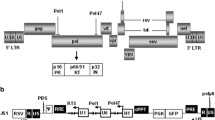Abstract
This study mathematically and computationally analyzes the effects of a combination of a chemical mutagen and an immune checkpoint inhibitor to develop an alternative anti-retroviral therapy. First, we addressed how the condition for HIV cure depends the efficacy of these two agents. We concluded that HIV cure only depends on the efficacy of the chemical mutagen, not on the immune checkpoint inhibitor. In other words, the combinatorial use of the two agents did not affect the necessary condition for the HIV “cured state”. On the other hand, we confirmed the effectiveness of the combinatorial treatment with the two agents on the eradication of productively infected cells. Computer simulations clarified that combination treatment with the two agents enables eradication of productively infected cells faster than does treatment with the mutagen alone.




Similar content being viewed by others
References
Loeb LA, Essigmann JM, Kazazi F et al (1999) Lethal mutagenesis of HIV with mutagenic nucleoside analogs. Proc Natl Acad Sci USA 96:1492–1497
Mullins JI, Heath L, Hughes JP et al (2011) Mutation of HIV-1 genomes in a clinical population treated with the mutagenic nucleoside KP1461. PLoS ONE 6(1):e15135. https://doi.org/10.1371/journal.pone.0015135
Harada K (2019) A mathematical study for the development of anti-HIV-1 therapies based on the lethal mutagenesis method. Artif Life Robot. https://doi.org/10.1007/s10015-019-00578-2
Gay CL, Bosch RJ, Ritz J et al (2017) Clinical trial of the anti-PD-L1 antibody BMS-936559 in HIV-1 infected participants on suppressive antiretroviral therapy. J Infect Dis 215(11):1725–1733. https://doi.org/10.1093/infdis/jix191
Day CL, Kaufmann DE, Kiepiela P et al (2006) PD-1 expression on HIV-specific T cells is associated with T-cell exhaustion and disease progression. Nature 443(7109):350–354
Trautmann L, Janbazian L, Chomont N et al (2006) Upregulation of PD-1 expression on HIV-specific CD8+ T cells leads to reversible immune dysfunction. Nat Med 12(10):1198–1202
Chu HH, Chan SW, Gosling JP et al (2016) Continuous effector CD8(+) T cell production in a controlled persistent infection is sustained by a proliferative intermediate population. Immunity 45(1):159–171
Sedaghat AR, Siliciano RF, Wilke CO (2008) Low-level HIV-1 replication and the dynamics of the resting CD4+ T cell reservoir for HIV-1 in the setting of HAART. BMC Infect Dis 8:2. https://doi.org/10.1186/1471-2334-8-2
Callaway DS, Perelson AS (2002) HIV-1 infection and low steady state viral loads. Bull Math Biol 64(1):29–64
Guo T, Qiu Z (2019) The effects of CTL immune response on HIV infection model with potent therapy, latently infected cells and cell-to-cell viral transmission. Math Biosci Eng 16(6):6822–6841
Mansky LM, Temin HM (1995) Lower in vivo mutation rate of human immunodeficiency virus type 1 than that predicted from the fidelity of purified reverse transcriptase. J Virol 69(8):5087–5094
Akhmetzyanova I, Drabczyk M, Neff CP, Gibbert K, Dietze KK, Werner T et al (2015) PD-L1 Expression on Retrovirus-Infected Cells Mediates Immune Escape from CD8+ T Cell Killing. PLoS Pathog 11(10):e1005224. https://doi.org/10.1371/journal.ppat.1005224
Lotka AJ (1910) Contribution to the Theory of Periodic Reaction. J Phys Chem 14(3):271–274. https://doi.org/10.1021/j150111a004
Finzi D, Hermankova M, Pierson T et al (1997) Identification of a reservoir for HIV-1 in patients on highly active antiretroviral therapy. Science 278(5341):1295–1300
Finzi D, Blankson J, Siliciano JD et al (1999) Latent infection of CD4+ T cells provides a mechanism for lifelong persistence of HIV-1, even in patients on effective combination therapy. Nat Med 5(5):512–517. https://doi.org/10.1038/8394
Hosmane NN, Kwon KJ, Bruner KM et al (2017) Proliferation of latently infected CD4+ T cells carrying replication-competent HIV-1: potential role in latent reservoir dynamics. J Exp Med 214(4):959–972. https://doi.org/10.1084/jem.20170193
Author information
Authors and Affiliations
Corresponding author
Additional information
Publisher's Note
Springer Nature remains neutral with regard to jurisdictional claims in published maps and institutional affiliations.
This work was presented in part at the 25th International Symposium on Artificial Life and Robotics (Beppu, Oita, January 22-24, 2020).
About this article
Cite this article
Harada, K., Sumi, T. A mathematical study on the effects of a combination of an immune checkpoint inhibitor and a mutagen for anti-HIV-1 therapy. Artif Life Robotics 26, 210–215 (2021). https://doi.org/10.1007/s10015-020-00664-w
Received:
Accepted:
Published:
Issue Date:
DOI: https://doi.org/10.1007/s10015-020-00664-w




